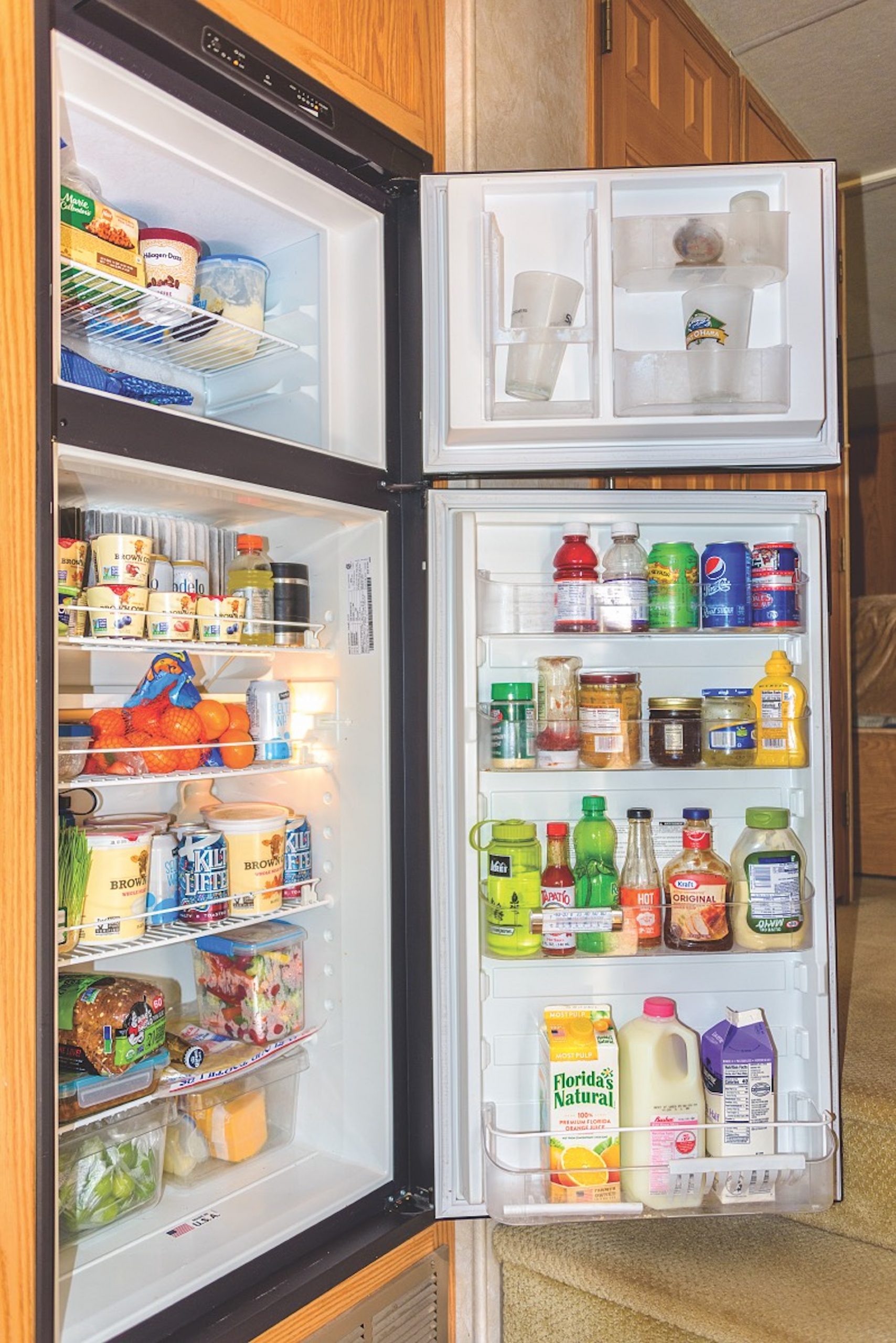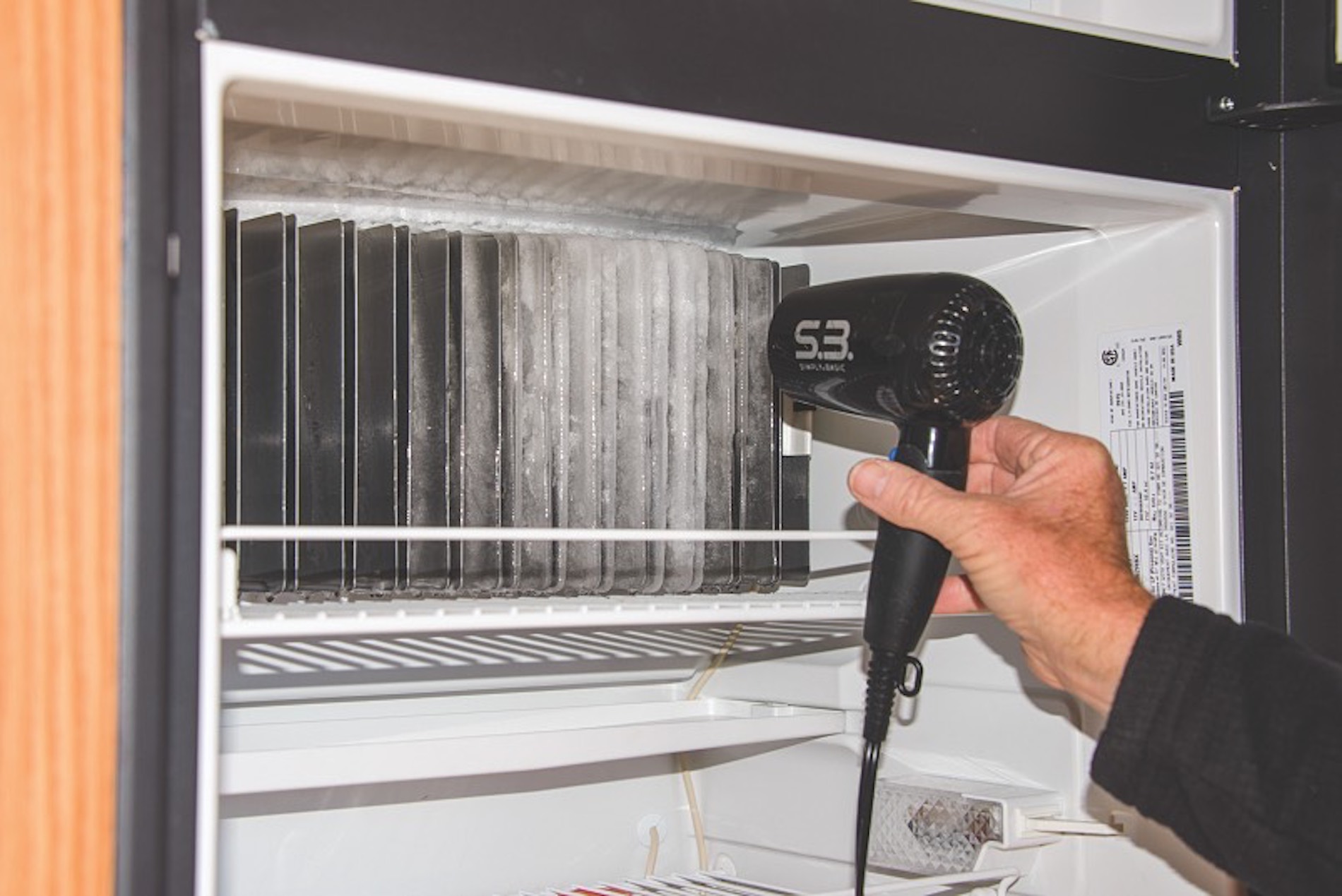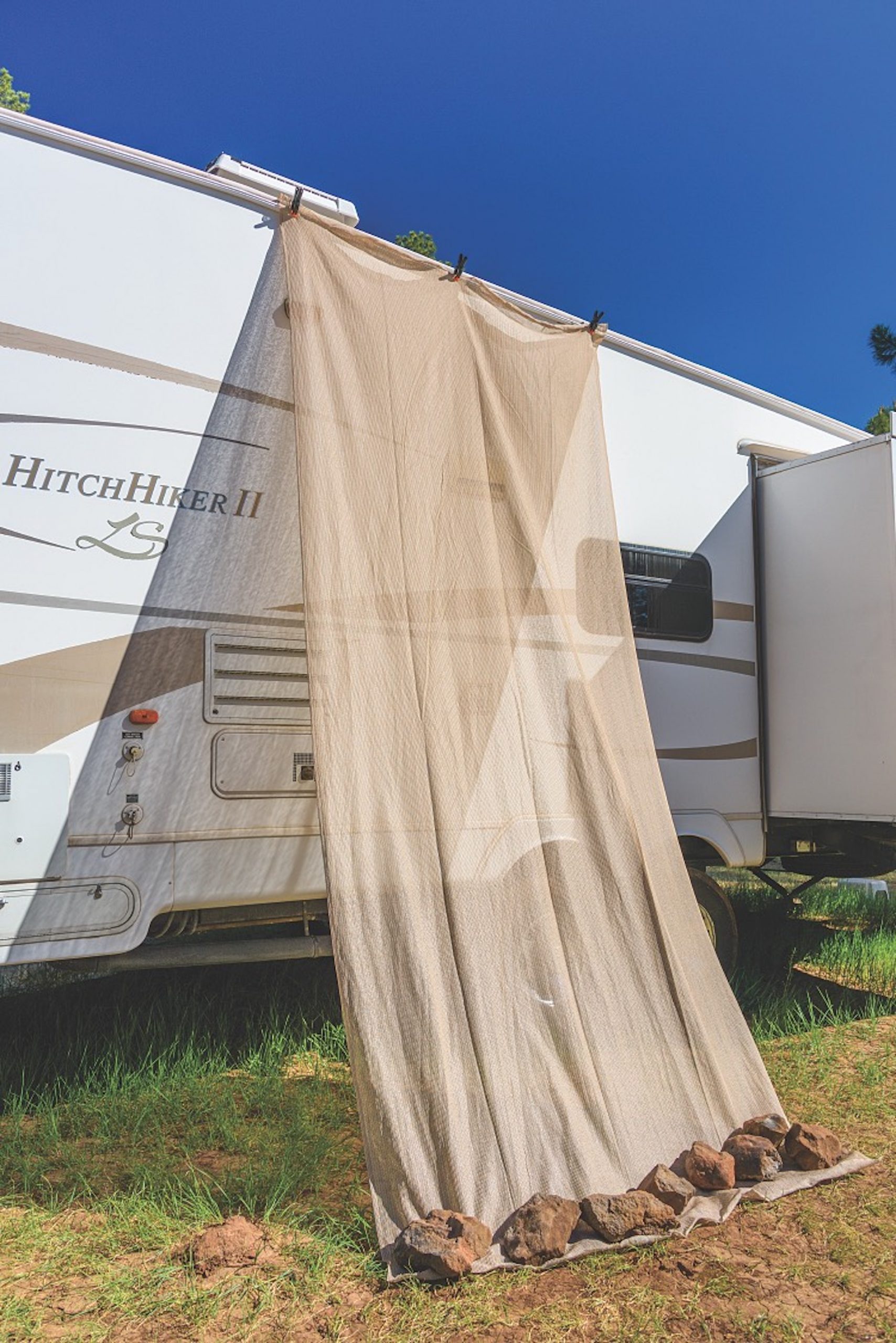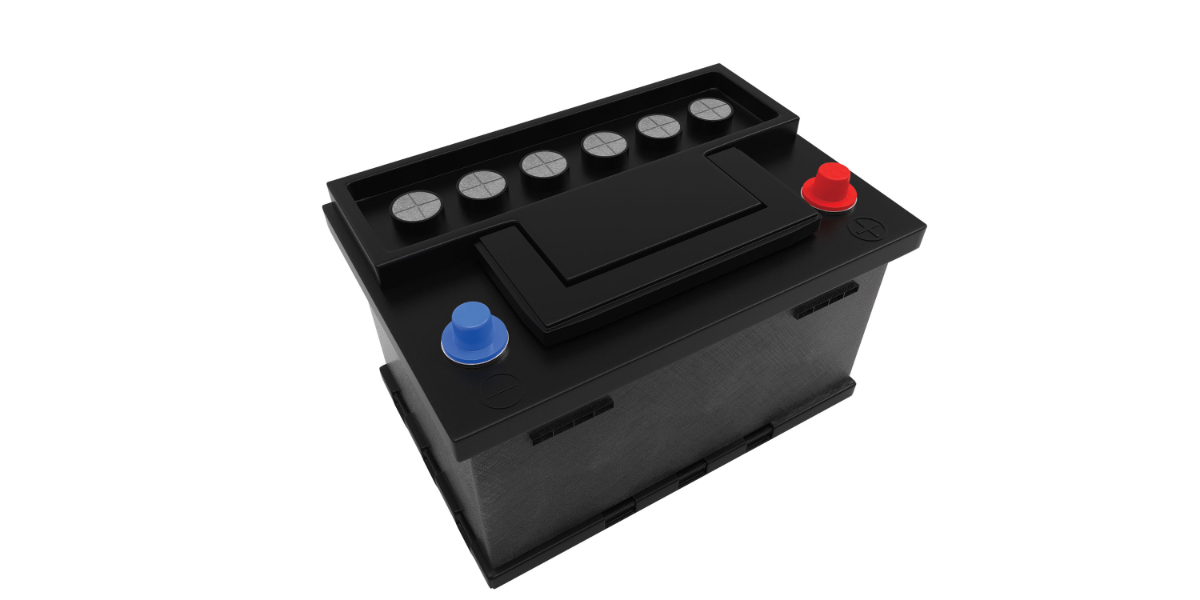Cool Operations
Here's How to Keep Your RV's Refrigerator Running Smoothly for the Entire Travel Season and Beyond
Image Caption: Image from author
One of the best things about traveling in an RV is the ability to bring along your favorite fixings for the ultimate campsite feast. is not only saves money but also allows you to eat healthier by hand-selecting the ingredients for your favorite recipes rather than leaving camp to eat out. Naturally, you need a place to store your perishables, and the refrigerator in your RV is perfect for the task. The only hiccup is that RV refrigerators can be quirky, and in thirteen years of living in our trailer full-time—predominantly without hookups—we’ve learned a few tricks to keep our fridge running smoothly.
Most new RVs are built with a two- or three-way (non-residential-style) refrigerator. These multipurpose-built fridges can operate on propane when electrical hookups aren’t available, can be operated on 120-volt ACshorepower, or, in the case of three-way refrigerators, can also be operated on 12-volt DCpower from the RV’s battery bank. Based on our hands-on experience, the following are some of our observations and most effective strategies for using an RV refrigerator.
Power Hungry
No matter the energy source, a large RV refrigerator requires a lot of power to keep food cold. For instance, our small eight-cubic-foot refrigerator requires ten gallons of propane per month to operate (without electrical hookups). We like our beer and other beverages cold, so we keep our fridge on the coldest setting. propane tank in your RV might provide more days of refrigeration than ours if you keep your fridge on a warmer setting. Size also matters, and a larger propane refrigerator with twice as much storage capacity as ours may require twice as much propane for the same period of time.
Likewise, operating a refrigerator on either120-volt AC or 12-volt DC electricity requires a lot of power. If that power comes from electrical hookups, the drain is not noticeable, but if it comes from the house battery bank while camping o -grid, both a large battery bank and a large-capacity charging source (whether a generator or a solar-power array) will be necessary to keep the batteries topped off.
Organization Is Key
Propane-based RV refrigerators are built with travel in mind, and the shelving, drawers, and in-door storage—as well as the door latches—are all designed to protect the food and containers from being bounced around. Usually, the front of each shelf is up to form a restraint, and the fridge and freezer doors latch securely.
Conventional residential refrigerators are more energy-efficient and cost a lot less than RV propane refrigerators, but they are not built for travel. Some kind of latching mechanism must be installed to keep the outer doors shut while in transit, and the shelves don’t have built-in restraints to keep things from sliding around. Many RVers place plastic tubs on the shelves to contain everything while driving. This is also a great way to categorize the contents of the fridge; for instance, keeping condiments in one container, individually packaged drinks in another, and containers of leftovers in another.
Fresh Factors
Sometimes inspiration takes a little while to strike, and it was only after ten years of overseeing the turf wars between the beer cans and the plastic bags of veggies in our small fridge that I came up with an idea for better vegetable storage.
I bought a tall half-gallon-sized plastic storage container with a flip-top lid, and now, rather than keep a slew of partially cut veggies in individual plastic bags in the vegetable storage drawer, I coarsely chop up all the veggies into the storage container on shopping day, remove the peels and stalks as necessary, and discard the plastic bags. The container holds anywhere from four to seven vegetables, and I layer them a few pieces at a time, so all the veggies are premixed.

Image from author
At mealtime, I grab my handy-dandy box-o-veggies and dump a few chunks into whatever pot, pan, or salad bowl I need for the meal and away we go. If I need smaller-sized pieces, I dice or mince them further. Whether they are destined to be sautéed, steamed, boiled, or baked, the amount of prep time needed is hugely reduced. No more grappling with messy plastic bags or stalks, leaves, and skins, and in my experience, the air-tight container keeps veggies fresher longer.
Granted, we are eating basically the same veggie mix at every meal, but each time I shop, I create a different mix. Almost every vegetable responds well to this treatment, including broccoli, cauliflower, celery, all types of squash, sweet potatoes and yams, potatoes, bell peppers, cherry and grape tomatoes, green beans, snap peas, baby carrots, and red onions. Some of these cook faster than others, so I sort them prior to cooking and start the thicker-root types early and throw in the broccoli and thin-skinned tomatoes at the end.
This simple technique has revolutionized not only our fridge maintenance but my RV cooking as well.
Twenty-Minute Defrost
One of the more burdensome aspects of a propane RV refrigerator is the need to defrost it every few weeks. After decades of living at home with wondrous frost-free refrigerators, a whole generation of lucky young RVers are new to this old-fashioned chore, but it doesn’t have to be di cult.
For years, we laboriously unloaded our entire RV refrigerator for the defrosting job. Then, one day, my husband, Mark, pointed out that most of our food can survive being slightly warm for the short time it takes to defrost the fridge. So, now we leave all the fruit, veggies, drinks, cheese, and most condiments on their shelves in the refrigerator throughout the defrosting process, which now takes just twenty minutes.
Temperature-sensitive items like milk, yogurt, ice cream, frozen and chilled meat, and mayonnaise must remain as cold as possible, so we turn o the fridge and move them into a cooler bag (any kind of cooler will do). If the air in the RV is warm, especially in the summertime, we cover the cooler bag with blankets for more insulation.
With the cooler bag set aside, we put a highly absorbent chamois towel inthe freezer. Mark then sets a portable hair dryer on lowand continuously waves itback and forth inside the freezer. At the beginning, with the walls of the freezer caked in ice, he keeps the hair dryer about four to five inches away. As the ice melts, he increases the distance to about eight to ten inches. Throughout, he keeps the hair dryer in constant motion. As the ice melts, he uses the chamois towel to collect the ice and wipe the freezer walls.

Image from author
After the freezer is partially defrosted, he begins to work on the fridge and blows the warm air onto the iced-up metal fins on the back wall of the refrigerator. Again, while the ice is thick, he holds the hair dryer four to five inches from the fins. As ice falls off the fins, he moves the hair dryer back to about eight to ten inches and keeps a continuous slow, waving motion so no single area receives aprolonged blast of hot air.
A tray below the top refrigerator shelf catches the ice and fills with water during defrosting. When the tray is full, he dumps it in the kitchen sink. Outside the RV, the refrigerator vent also begins to drip a dribble of water down the side ofour trailer.
Going back and forth between work-ing on the freezer and the fridge, the ice is all melted and wiped away after about fifteen minutes. At that point we reload the items from the cooler back into their places on the shelves and set the fridge to its coldest setting until it cools down again. That’s it!
Keeping it Cool
Most RV refrigerators are located on an outside wall of the RV. Upon installation, a large rectangular portion of the insulated outer wall is removed for venting and to provide access to the mechanical parts of the refrigerator. When summer temperatures heat up and the sun shines directly on this partially insulated wall of the rig, the refrigerator is exposed to a lot of heat. Besides making it more difficult to keep the fridge cold, frost also builds up more quickly.
In the dog days of summer, if our efrigerator wall is facing the sun in the heat of the afternoon, we clamp a large piece of UV-resistant cloth (90 percentrating) to the roof gutters above the fridge vent and hold it down on the ground with some rocks. This makeshift shade does wonders for reducing the heat on the wall and helps the fridge stay cool. It isn’t elegant or permanent, but it works!

Image from author
Everybody talks about how certain gadgets or appliances are the “unsung heroes” of RVing. Your RV refrigerator is definitely worthy of that title and makes your RV a true home on wheels with luxuries like ice cubes and ice cream. With some planning, maintenance, and a little TLC, your RV’s refrigerator will continue to provide the perfect haven for your perishable items.





